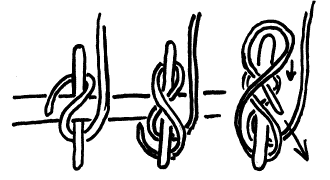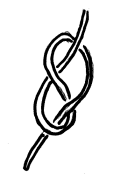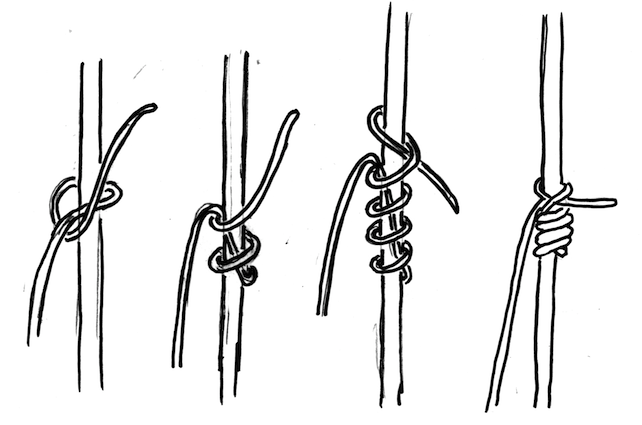There are two forms of kernmantle rope:
Single-braid: a braided mantle around a core of parallel fibers. Core may just be filler, but often adds greatly to strength of rope, depending on material used.
Double braid: literally, a braided mantle around a braided core, a rope within a rope.
Often stiffer than single braid, harder hand, great tendency to "milk".
Material strength:
Based on Safe Working Load or SWL; ultimate break strength is at least 5x's SWL
| Fiber | Rope Diameters | |||
|---|---|---|---|---|
| 3/8" | 1/2" | 3/4" | 1" | |
| Natural Fiber | ||||
| Manila | 200 | 440 | 1080 | 1880 |
| Sisal | 150 | 350 | 865 | 1440 |
| Synthetics | ||||
| Nylon | 400 | 780 | 1800 | 3600 |
| Dacron | 390 | 745 | 1870 | 3220 |
| Polypro | 300 | 600 | 1600 | 2800 |
Knots
There are thousands of knots for all kinds of rope work. On stage, many ropes and knots are used. There are a handful of knots every stagehand should know which will cover the vast majority of needs.
The parts of a rope are: The Ends and the Standing Line (the long middle part of a rope not in the knot). A Bight is a bend in the rope that does not cross back across itself. A Loop is a bend in the rope that DOES cross itself. A Hitch is knot that ties a rope to something else, a Bend is a knot that joins two ropes. The Bitter End is the very end of the rope, especially if you are sliding down it!

The Bowline is THE prime theatre knot. Tied properly it WILL NOT slip. If you remember only one knot, this is it. It is used to tie a fixed loop in the end of a rope. Riggers use it on a rigging line to send equipment into the air. Electricians use it to send instruments up to the beams on a rope. It can make a non-slip loop around an object, or if tied back around the rope like a lasso, will tighten down on the object. It can even be used to tie two ropes together by putting a bowline in the end of one line, then tying a bowline in the end of the other through the first bowline. This is the best method of adding rope to a spotline on a "rope" system that is a little short, because it is even more secure than a sheet bend in stiff, heavy ropes.

The Square Knot a binding knot used to tie a rope around something to secure it. It can also be used to tie two identical ropes together, but the MUST be of the same size, material, age, and condition, or the knot WILL slip. For joining two ropes, a sheet bend is superior.

The Sheet Bend is used for joining two ropes. It will work with identical ropes or ropes of different sizes, materials, and stiffness. It is less likely than a square knot to slip.

A Clove Hitch is used to tie a rope to a batten or post. It is usually finished with a half-hitch stopper back around the standing line to prevent slippage, as a safety. If you learn only two knots, the bowline is the first, and this is probably the second.

Two Half-hitches are also used to tie a rope to a batten or post, but by itself it not as strong as a clove hitch. However, if the rope is passed around the bar two or three times and then secured with two half hitches, it will be very strong. This method is especially useful for dead-hanging something directly from an overhead support.

Tie-line Knot or Larks head is used to attach a tie-lines to the grommets of a curtain or drop so it can be tied to a batten.
 Pin-rail Tie-off or Belay knot is used to tie the ropes of a ropes system to the belay pins of a pin-rail.
Pin-rail Tie-off or Belay knot is used to tie the ropes of a ropes system to the belay pins of a pin-rail.

Prusik knot is used to attach a wire rope loop to the batten ropes of a ropes system. Sandbags are then clipped to the loop as counterweight.
 A Figure-8 knot is used to put a knot in a rope so it won't accidentally run back through a pulley or sheave. It can also be useful to keep the end of a rope from unraveling.
A Figure-8 knot is used to put a knot in a rope so it won't accidentally run back through a pulley or sheave. It can also be useful to keep the end of a rope from unraveling.


Snubbing can be used to temporarily secure an out-of-weight line-set until the weight can be adjusted. One end of the "snub line" is secured to the rail with a fixed eye knot, such as a bowline. The other end of the line is snubbed to the operating line. This Snub knot is one of several that can be used for the purpose.